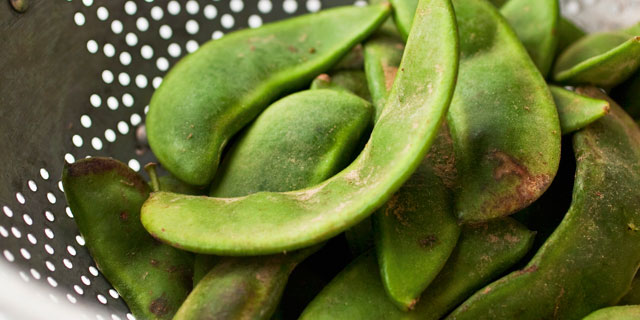Known as
broad beans and Windsor beans, favas are
deliciously plump legumes that hide within them mildly sweet fava beans. They are in season right after green peas and
before the string beans make it to market, making them the culinary signal that
the height of spring has arrived.
Fava beans
may be a bit time consuming to prep, but their delicate flavor and nutritional
punch makes them a spring time favorite! A one cup serving of fava beans packs
10 grams of protein and 9 grams of dietary fiber. Fava beans are a wonderful
source of potassium, which helps lower blood pressure, and iron, an essential
component in making red blood cells and preventing anemia. Rich in a slew of
vitamins and minerals including Vitamin K, Vitamin B, and magnesium, and
clocking it at just 115 calories per cup, they are a wonderful way to boost the
nutrition and flavor in your diet.
How do I pick the best fava beans?
To choose
the best fava beans, select pods that are a rich green color and feel firm to
the touch. Look for pods with small bumps, indicating that the beans inside are
young and tender. Skip over any pods that have bulging bumps, are slimy,
withered or dull in color, which indicates the pods are older and the beans
within will likely be bitter tasting. The outside of the pod should be smooth,
with no nicks, cuts, or soft spots.
What can I make with fava beans?
Fava beans
are so sweet and tender that they are often enjoyed raw, straight out of the
pod. Throw fava beans into a fresh salad, sauté in a garlic and butter sauce,
toss into pasta dishes or puree into a bright pesto. From soups and sauces,
fava bean chimichurri would be rich and bold, to a creamy and rich fava bean
mint ice-cream, the culinary possibilities for these little beans are endless.
To prep fava beans you
must first start with the pods. Snap pods as you would a twig, then using your
finger pop out the beans into a clean bowl. Depending on the variety, there may
only be 5-10 beans per pod. If the small jackets or thin shells on the beans
are white, blanch beans, transfer to an ice bath, and remove promptly. The
beans can be popped out of their shells with gentle pressure or peeled off. If
the jackets have not yet turned white there is no need to remove them. Once
prepped, use beans as your recipe indicates or enjoy them fresh from the pod.
Young pods will keep fresh
in the fridge for up to a week. If shelled, fava beans will remain fresh for
3-4 days. For longer storage, follow the prep process then pat dry. Transfer
fava beans to a freezer safe bag with excess air removed. Frozen fava beans
will keep for up to a year.
Recipes to
try include: Black and White Bean Salad, Barley and Fava Bean Soup, and Solterito (Andean Cheese, Fava Bean and Corn Salad).


![Making Mealtime Matter with La Familia: Easy Sofrito [Video]](https://thelatinkitchen.com/wp-content/uploads/2015/10/sofrito-shutterstock__0-500x383.jpg)
![Easy Latin Smoothies: Goji Berry Smoothie [Video]](https://thelatinkitchen.com/wp-content/uploads/2015/12/goji_berry-shutterstock_-500x383.jpg)
















![Fun and Fast Recipes: Fiesta Cabbage Salad [Video]](https://thelatinkitchen.com/wp-content/uploads/2015/11/fiesta_cabbage_slaw-shutterstock_-500x383.jpg)









